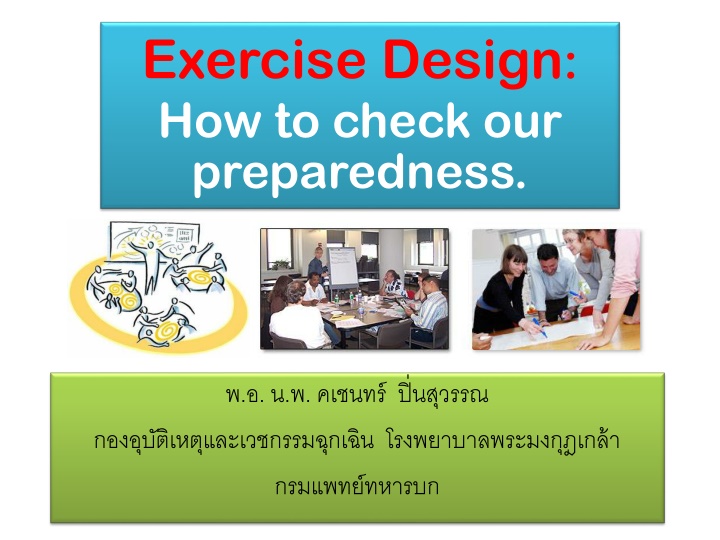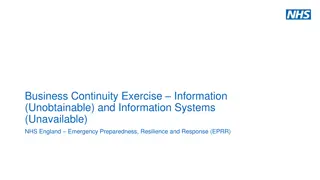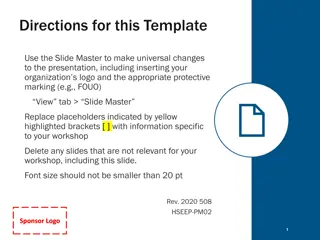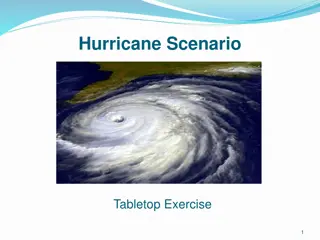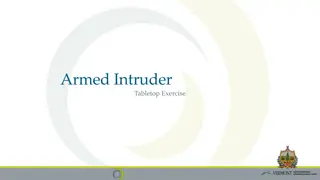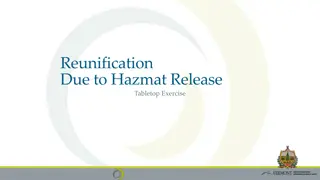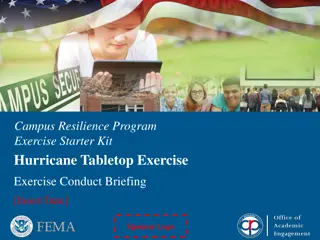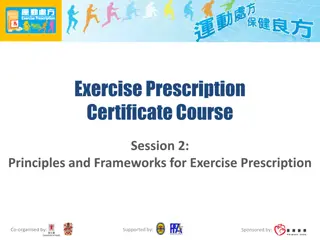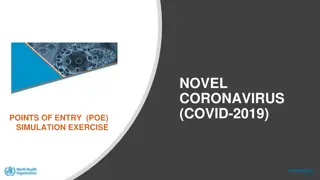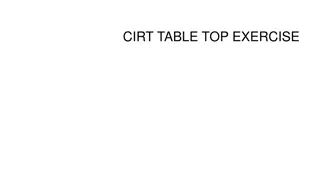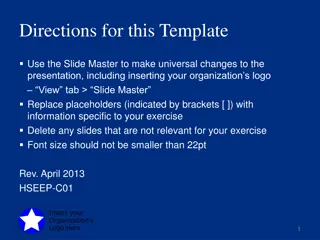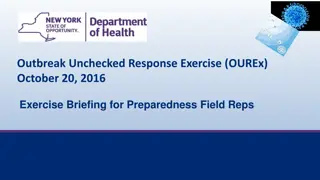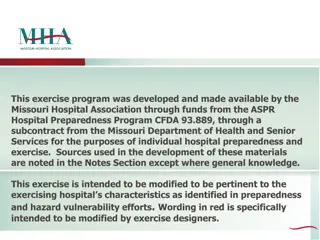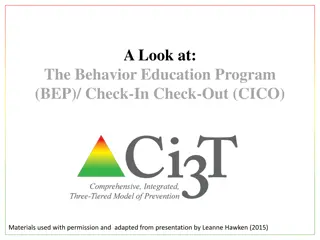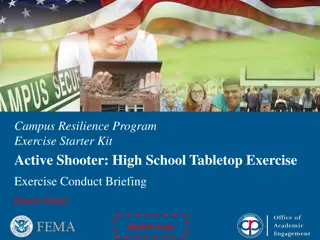How to Check Preparedness: Exercise Design and Benefits
This content discusses the importance of exercise in testing preparedness, highlighting its purpose, benefits, and focus. It emphasizes the need to evaluate plans, reveal weaknesses, and train personnel to improve organizational readiness. Through simulated scenarios, exercises help identify and address potential problems before real emergencies occur, leading to improved coordination and communication within organizations.
Download Presentation

Please find below an Image/Link to download the presentation.
The content on the website is provided AS IS for your information and personal use only. It may not be sold, licensed, or shared on other websites without obtaining consent from the author.If you encounter any issues during the download, it is possible that the publisher has removed the file from their server.
You are allowed to download the files provided on this website for personal or commercial use, subject to the condition that they are used lawfully. All files are the property of their respective owners.
The content on the website is provided AS IS for your information and personal use only. It may not be sold, licensed, or shared on other websites without obtaining consent from the author.
E N D
Presentation Transcript
Exercise Design: How to check our preparedness. . . . .
?? ? ? ? ? ? ?
What is Exercise? Exercise: is a focused practice activity that place participants in a simulated situation requiring them to function in the capacity that would be expected of them in a real event Purpose: to promote preparedness by testing policies and plans and training personnel
Why Exercise? Many of real events proof that exercise is the most useful key success factor. Research has shown that people generally respond to an emergency in the way that they have trained.
Main benefits of an exercise program Individual training: exercise enables people to practice their roles and gain experience in those roles System improvement: Exercise improve the organization s system for managing emergencies
Reason to exercise Test and evaluate plans, policies, and procedures Reveal planning weaknesses Reveal gaps in resources Improve organizational coordination and communication Clarify role and responsibilities
Reason to exercise Train personnel in roles and responsibilities Improve individual performance Gain program recognition and support of officials Satisfy regulatory requirements
Focus of an exercise Locating and eliminating problems before an actual emergency occurs Corrective actions are an important part of exercise design, evaluation, and follow up
.. HA, JCI, , ? ...
Functions In planning exercise, the emphasis is on functions rather than on type of emergency, because preparedness in those functions is common to all emergencies. Functions are actions or operations required in emergency response or recovery
Functions in Emergency Management Exercise Reporting System Alert notification (Emergency Response) Warning (Public) Communications Coordination and control Emergency Public Information Damage Assessment Health and Medical
Functions in Emergency Management Exercise Reporting System Individual/Family Assistance Public safety Public work/Engineering Transportation Resource Management Continuity of government
Comprehensive Exercise Program Made up of progressively complex exercise, each one building on the previous one, until the exercise are close to reality as possible
Progressive exercise: Characteristics The exercise program involves the efforts and participation of various entities Carefully planned to achieve identified goals Made up of a series of increasingly complex exercises Each successive exercise builds upon the previous one until mastery is achieved
Progressive Exercising Broad commitment Careful planning Increasing complexity Success breeds Success Who participates?
8 8 Step of Step of Exercise design process Exercise design process Assess needs Define the scope Write a purpose statement Define objectives Compose of narrative Write major & detailed events List expected actions Prepare messages
What activities are included? Orientation seminar Drill Tabletop exercise Functional exercise Full-scale exercise
Orientation seminar: Purpose the orientation seminar is anoverview or introduction. Its purpose is to familiarize participants with roles, plans, procedures, or equipment. It can also be used to resolve questions of coordination and assignment of responsibilities.
Orientation seminar: Characteristics Format: lecture, group discussion, presentation, panel discussion, guest lecture Participants: cross-functional to discuss the problems Facilities: conference room Time: 1-2 hours Preparation: easy, 1-2 weeks
Orientation seminar: Application The orientation seminar can be used for a wide variety of purposes, including: Discussinga topic or problem in a group setting. Introducingsomething new (e.g., policies and plans). Explainingexisting plans to new people
Orientation seminar: Application Introducing a cycle of exercises or preparing participants for success in more complex exercises. Motivating people for participation in subsequent exercises.
Orientation Seminar Guidelines Be Creative Get Organized and Plan ahead Be Ready to Facilitate successful orientation seminar
Tabletop Exercise A tabletop exercise is a facilitated analysis of an emergency situation in an informal, stress-free environment. The tabletop is largely a Discussion guided by a facilitator
Tabletop Exercise Purpose: to solve problems as a group. The success of a tabletop exercise is determined by feedback from participants and the impact this feedback has on the evaluation and revision of policies, plans, and procedures.
Advantage Requires only a modest commitment in terms of time, cost, and resources. Is an effective method for reviewing plans, procedures, and policies. Is a good way to acquaint key personnel with emergency responsibilities, procedures, and one another.
Disadvantage Lacks realism and thus does not provide a true test of an emergency management system s capabilities. Provides only a superficial exercise of plans, procedures, and staff capabilities. Does not provide a practical way to demonstrate system overload.
How a Tabletop works a tabletop exercise is like a problem- solving or brainstorming session. Unlike a functional exercise, problems are tackled one at a time and talked through without stress.
How a Tabletop works Problem Statements and Messages: , Facilities and Materials:
Facilitating a Tabletop Exercise Facilitating a Tabletop Exercise Facilitator s responsibilities Setting the stage Involving everyone
Facilitating a Tabletop Exercise Facilitating a Tabletop Exercise Facilitating in-dept problem solving Controlling the pace and flow of the exercise & distributing messages
Facilitators Characters Good personality & Health Good Listener: focused point Best Communication Conflict management Group Dynamics Conductor Friendly , Open mind
Roles of Participants in Tabletop Exercise Get the problem statement, analyze it Open discussion, Group dynamics Think to all options, it is possible?, don t hurry Depend on your emergency plan, policies, and procedures If you find any new problem or weakness of the plan. Try to solve its. Give any suggestions
Goal and Objective of the Exercise Know & familiar with EOP Role & responsibility in EOP Individual training specific skill Cooperation & Coordination Test Emergency response system
